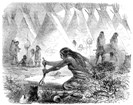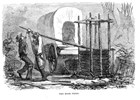Bent’s Fort was built first and foremost for the growing bison robe trade. Ceran St. Vrain stated in 1847 that the fort was established “for the purpose of trading with the several tribes of Indians in its vicinity.” The primary offerings of these plains tribes were, of course, bison robes and horses. Even the fort’s location was determined with an aim toward best facilitating this robe trade. This trade would transform the southern plains.
-
Article 1: Hunting and Processing Bison Robes

The thousands of buffalo robes traded at Bent’s Fort and many other trading posts in the Far West were eventually made into lap robes for use in carriages and sleighs during the winter months in both the United States and Europe; some robes were fabricated into heavy outer garments such as coats, mittens, and hats. Learn more about how Plains Tribes served a key role in this process. Read more
-
Article 2: Packing Bison Hides for Trade

Bison robes purchased by the trader were transported for trade and sale in compressed and bound bales called “packs.” A contemporary source states that a “pack of robes generally embraces ten skins, and weighs about eighty pounds.” Yet the packs might actually contain as many as twelve robes each, and those packs of calf robes, which were smaller, could contain as many as twenty. These robe packs were made with the use of a “press.” Read more
-
Article 3: Impacts of the Bison Robe Trade

The effects of the bison robe trade, both on the Plains Tribes and Bent’s Fort, were many. Robe trader’s manufactured goods proved irresistible to the Plains Tribes, to the point that they lost a margin of former self-sufficiency, becoming dependent upon traders. Bent’s Fort became not only a draw for certain tribes but a sort of hub around which the political, economic, and even social affairs of the Southern Cheyennes and others were often played out. Read more
